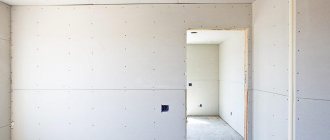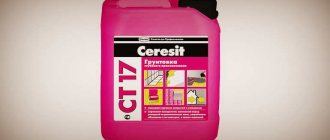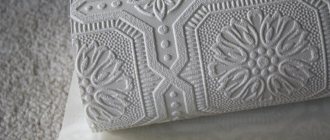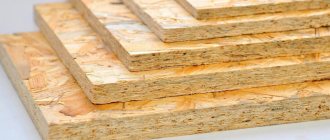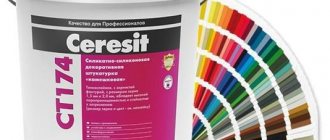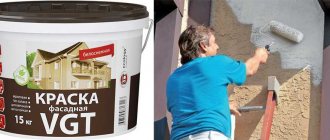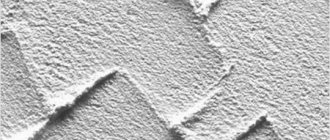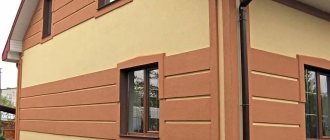The beauty and durability of any building is due to high-quality construction work. Compliance with certain technical rules and the use of high-quality materials increases the building’s resistance to negative environmental conditions, ensures ergonomics and aesthetic performance. Modern renovation involves the use of special coatings for interior and exterior work, which improve the functions of load-bearing structures. One type of such mixtures is primer for facades.
Purpose and application
Facade primer is a special coating for application to the outside of houses. The solution improves the adhesion of building materials to decorative elements and levels the outer walls. In the conditions of further finishing work, the consumption of the finishing coating is reduced, the strength of the building and resistance to weather fluctuations are increased.
Why do you need façade primer?
External walls are constantly exposed to various negative influences, which lead to the destruction of materials. Moreover, this applies not only to plastered or painted surfaces, but also to facades covered with plastic and metal. The biggest problem is moisture: it saturates the plaster, penetrates into the pores of the walls, under the sheathing, as a result of which the finish peels off, corrosion and mold appear. It is the primer that gives the walls reliable protection from moisture, forming a thin but very durable water-repellent layer. After impregnation with a primer, the surfaces do not absorb water even during periods of prolonged rain.
Priming the walls
In addition to increasing water resistance, primer compositions also perform other functions:
- provide stable adhesion between the base and the finishing coating, allowing for a more even distribution of the finishing material over the surface;
- strengthen foundations prone to crumbling by deep penetration and filling pores;
- reduce the consumption of decorative materials when finishing the facade;
- Thanks to special additives, they provide additional protection against fire, corrosion of metal elements and the development of fungi.
Why prime the façade of a house at all?
Composition and technical characteristics
The primer for the facade differs from other types of external coatings, taking into account the increased requirements for them. The necessary qualities are provided by the chemical and physical composition. The presence of certain components depends on the type of construction impregnation. The main options are represented by the following primers.
- Acrylic - the main substance is a solution of polymer resin. Additional elements are water, plant components, sand, abrasive particles, and dyes. The solutions are universal, suitable for most external walls. They have virtually no toxic effect and are odorless. Dries very quickly upon application. Dilutes well with water.
- Alkyd - the base substance is a synthetic polymer that dries quickly and prevents corrosion. Therefore, it is successfully used for initial processing of wood and metal structures. Has high hygroscopic properties. Relatively inexpensive type of base. An excellent base for ceramic tiles.
- Mineral - the composition includes components such as lime, cement, gypsum. The solution serves as a base when working with wet mineral materials - concrete, brick, plaster. Thick consistency evens outer coatings. However, the external primer should be selected taking into account the type of base coating.
- Universal two-component based on a polyurethane component - suitable for most walls as a starting solution. Easy to use, dries quickly, and is highly resistant to external factors. The only drawback is the high price of a universal primer.
- A base solution with alkali-resistant quartz sand creates an outer surface with a rough structure. Thanks to its special composition, it has unique properties that promote adhesion of materials.
Considering the variety of façade primers, before purchasing, you should read the instructions for use.
Attention! Application features, technical parameters and consumption indicators of external impregnations are indicated on the label attached to the package.
Consumption per 1 m2
For different types of mixtures, there are certain criteria for the volume needed for application. The composition of the primer for exterior use determines the amount of substance provided for sufficient impregnation of the walls. The calculation is carried out per square meter of coverage.
- If you use acrylic facade primer, take up to 120 - 150 ml.
- Alkyd mixtures for wood, chipboard, MDP use from 100 to 120 ml.
- When you need to prepare metal surfaces for painting, you will need 80 - 120 ml of starting composition.
- When using primers for deep penetration of facades, you should take about 100 ml.
- The amount of mineral solution is 300 ml.
- Most anti-corrosion exterior primer mixtures are calculated based on an amount of 60 to 80 g per square meter.
However, before purchasing, you should read the information on the label, where the manufacturer indicates the exact amount of the exterior mixture required to treat external surfaces. In this case, it is necessary to take into account the type of material on which the primer will be applied. The more pores and small cracks, the more mixture you will need.
Hygroscopic, friable material may require several layers. The volume of the consumable solution is affected by environmental conditions and the type of decorative coating. If the main walls of the building are subsequently covered with siding, porcelain stoneware, stone, then one layer of base mortar is applied. Before painting, the surface should be primed at least twice.
Calculation of the amount of primer
Before starting work, you should accurately calculate how much primer you will need to treat the facade. This is not at all difficult to do. Consumption depends most on two factors - the composition of the mixture and the base material.
On average, primer consumption rates are as follows:
- alkyd – 120 g/m2;
- acrylic – 150 g/m2;
- mineral – 300 g/m2;
Facade primer consumption
The consumption of anti-corrosion primers when applied to a metal base is about 60-80 g/m2. More accurate values for each specific type are indicated by the manufacturer on the packaging. Next, you should take into account the quality of the surface that will be primed - the more porous the base, the greater the consumption. If the wall material is quite loose, porous, and highly absorbent, the primer is applied in two or even three layers. Additionally, take into account the operating conditions and the type of finishing coating: one layer is enough for siding, stone or porcelain stoneware; for painting or decorative plaster, it is better to apply 2 layers, especially if the house is located in a damp area.
For calculations, you need to determine the total area of the facade, multiply it by the consumption rate for 1 m2 and by the number of layers. For example, the facade area is 75 m2, the base material is cement-sand plaster, it is planned to prime it in 2 layers with acrylic composition. We perform calculations:
75 m2 x 0.15 kg x 2 = 22.5 kg
Depending on the volume received, select the optimal packaging so that you do not overpay and have a small supply of material left. For example, FARBITEX acrylic primer is packaged in containers of 3, 5 and 10 kg, so in our case it is best to purchase 2 containers of 10 kg and 1 three-kilogram container.
Deep penetration acrylic primer
Comparative table of façade primers from different manufacturers
| Name | Brief characteristics | Average market value |
Deep penetration soil BOLARS | Transparent acrylic-based composition, intended for substrates with a high degree of water absorption - brickwork, concrete, aerated concrete blocks. The average consumption is 80 g/m2, drying time is 60 minutes. Packaged in cans of 1 kg, canisters of 10, 5 and 3.5 kg, tanks of 30 and 40 kg | 520 rub. /10 kg |
Primer CERESIT CT 16 | Acrylic composition intended for the preparation of concrete, cement-sand, brick surfaces, as well as particle boards for decorative plaster and painting. Consumption is 200-500 g/m2, drying period is 3-6 hours. Packaging 10 and 5 l | 1180 rub./10 l |
"Knauf" Betokontakt | Polymer-based composition containing quartz sand. It has increased adhesive properties. Designed for preparing concrete bases for plastering and painting. Consumption 350 g/m2, drying period 3-4 hours. Packaged in containers of 5 and 20 kg | 518 rub./5 kg |
KNAUF Tiefengrund | Universal composition of deep penetration. Designed for all types of substrates for tiling, painting and decorative plaster. Consumption is 70-100 g/m2, drying time 30-50 minutes | 720 rub./10l |
Belinka Base | Alkyd primer used for treating wooden facades. Contains antiseptics. Average consumption 100 ml/m2, drying time 10-12 hours. Packaged in containers of 1, 2.5, 5 and 10 l | 2505 RUR/5l |
Calculation formula
The consumption of primer material is determined by a formula that takes into account the following parameters:
- indicator of outer surface area;
- the amount of primer per square meter, which is indicated in the manufacturer’s instructions;
- multiplicity of layers.
The product of all parameters provides objective information about the volume of external primer that is necessary to carry out basic work.
Applying primer
Work order:
- We dilute the primer composition in a container with water in accordance with the instructions of the manufacturer.
- Stir the resulting composition and apply it to the surface using a wide brush or long-haired roller.
- The mixture must be applied so that no streaks or drops are formed. Usually one layer is enough. However, if the material quickly absorbs the primer, repeat the procedure a second time.
- You can begin finishing work immediately after the soil dries (drying can take from 40 minutes to a couple of hours).
Note! It is necessary to prevent dust from entering the drying surface.
Peculiarities
The primer for facade work differs from other coatings in its properties. External walls of buildings or surfaces are affected by climatic conditions. Therefore, they must have special indicators:
- high resistance to atmospheric changes, humidity, temperature fluctuations;
- good penetrating ability;
- improved adhesive properties;
- increased insulating properties;
- do not change the functions of external structures;
- strengthening effect.
During application, the components penetrate into voids, small cracks and pores. Chemical compounds, getting deep into the walls, harden, providing the necessary insulating properties. There is a strong adhesion of the material to each other. The external primer also creates a surface layer that will protect the walls from negative influences and serve as an additional basis for further finishing work. Subsequently, when applying the finishing solution, the base composition does not allow the decorative paint to penetrate deeply. Therefore, the surface layer looks attractive and lasts longer.
Features of using primer
In order for the primer mixture to fulfill all its obligations and improve the condition of the wall surface, it is necessary to use it correctly.
The primer must be diluted strictly in the proportions stated by the manufacturer on the packaging. Otherwise, the product loses all its properties and its consumption will be pointless.
Under no circumstances should you refuse to carry out preparatory work. The walls in the room must be thoroughly cleaned of dirt, dust and other contaminants that may adversely affect the adhesion of the material and the base. If there are cracks on the wall, they must be eliminated using putty, and then the surface must be sanded to give it a smooth appearance.
Before carrying out priming work, it is necessary to carefully prepare the surface, cleaning it from old finishes, dirt and dust.
The primer is applied to the wall using a roller, but hard-to-reach areas can be treated with a brush. After diluting the composition, it must be used immediately, otherwise it may lose its beneficial properties. Each coat of primer can only be applied after the previous coat has completely dried. Drying time is indicated by the manufacturer on the packaging. When carrying out both internal and external finishing work, it is not recommended to save on this building mixture.
Primer selection and application methods
In order for the external walls of a building to last as long as possible, it is necessary to adhere to the recommendations for choosing a primer and its application. The mixture option is determined based on the type of base coatings. Compliance with these conditions improves the quality characteristics of the house.
Wooden facades
Surfaces made of natural materials must be well impregnated, given their tendency to accumulate moisture and have a high probability of being damaged by fungus and parasites. Therefore, preference is given to alkyd wood primers for exterior use with antiseptics and fungicidal components.
Brick and concrete facades
To ensure that the surface lasts a long time and has a good aesthetic appearance, the best primer option for concrete and brick for exterior use is bark beetle impregnation. The rough structure provides high adhesive properties and exhibits water-repellent function. Mineral and universal mixtures based on polyurethane are also suitable.
Metal facades
The main task of an external primer for metal is to prevent corrosion of the coating. Therefore, enamel primer and rust converters are used for these purposes. After applying such a base, the finishing layer can be easily applied in an even layer.
Compound
Most primers for façade use use acrylic resins as the main component. Causes?
There are several of them.
- Price. Acrylic (known, among other things, as plexiglass), as well as polymers similar in composition, is an affordable material, the production technology of which has long been established and is not associated with large overhead costs.
- Harmlessness. Acrylic primers and paints do not emit harmful substances during painting and operation, so they can be used not only for facade work, but also indoors.
- Chemical resistance and durability. Ultraviolet radiation, heating and cooling within reasonable limits do not affect the functionality of the soil.
Additional additives often include:
Latex that improves the adhesion of soil to substrates with low absorbency.
The addition of latex improves the adhesive qualities of the soil.
- Silicone that increases the water resistance of the soil.
- Fungicides (antiseptics).
- Pigments. They perform purely utilitarian functions - they allow you to control the area of the already primed surface.
Rules for applying the mixture
Certain priming steps must be followed.
Attention! If the procedure and equipment are violated, the service life of the facility is reduced and the quality of external finishing work is reduced.
Therefore, you should not neglect the processing rules, which consist of the following points.
- It is important to prepare the base surface for applying impregnating mixtures. To do this, the base should be cleaned of dirt and rust, and large and small cracks should be sealed.
- Study the instructions for each container with the mixture. When using concentrated products, the primer should be diluted to the desired consistency.
- Treat the surface from top to bottom using special tools. It is most convenient to use a roller, spray gun or brush. Depending on the type and properties of the base material, priming can be done one to three times.
- Leave the solution on the surface until completely dry. The average period is about 24 hours. If there is high humidity or significant fluctuations in ambient temperature, you must wait a few days.
At low temperatures, it is undesirable to carry out priming work on external surfaces. Because this can lead to a violation of the properties of the mixture. It is better to wait until the thermometer rises above + 5 degrees.
Surface priming rules
Facade preparation
Despite their adhesive properties, primer mixtures do not adhere well to surfaces covered with dust, soot from exhaust gases, and oil stains. Peeled and crumbling areas also cannot be primed, since they will begin to crumble during the application of the composition. In addition, the primer does not mask irregularities and cracks, and therefore all defects will be visible under the finish.
The surface is prepared according to SNiP 3.04.01-87. First, clean the façade of old plaster or paint and repair cracks, if any.
Removing old plaster
Areas blackened by mold must be cleaned with a metal brush and treated with a chlorine-containing preparation (you can use regular “whiteness”). Oil stains can be removed using any solvent. Metal elements are also degreased and cleaned of corrosion. Small areas of rust can be treated with coarse sandpaper, but if a large area is affected, it is better to use a wire brush or drill with a sanding attachment. Finally, the base should be cleaned of dust in any convenient way.
Wire brush with scraper
Grinding attachment for drill
SNiP 3.04.01-87. Insulating and finishing coatings. File for download
SNiP 3.04.01-87
Prices for popular electric drill models
Electric drills
Diluting the primer
Alkyd compositions are usually produced ready-to-use and do not need to be diluted; moreover, not every solvent is suitable for them. But acrylic-based primers can be diluted with plain water. In what cases is this done?
If the primer is sold in concentrated form, the instructions for use must indicate the proportions for diluting the solution with water. These may vary from manufacturer to manufacturer, so carefully read the information on the packaging. It is not advisable to apply the undiluted composition, since this will significantly increase the cost of repairs.
Diluting the soil
Important! The diluted concentrate must be used in full on the same day, since after a day its quality will noticeably deteriorate. Such solutions cannot be stored, even in tightly closed containers. It is also not allowed to pour the remaining diluted primer into a container with concentrate.
Experienced plasterers dilute the usual primer with water to save money when treating large-area facades. But only if the walls are concrete or brick, and the base is prepared for plastering or painting. Surfaces prone to crumbling cannot be treated with diluted primer, especially under putty and decorative plaster, since a weak binder content will cause the materials to peel off. When diluting, the mass fraction of water should not exceed 10% of the amount of soil.
We dilute two-component formulations according to the manufacturer’s instructions.
Applying primer to the surface
To prime the facade, a roller with a telescopic handle and a medium-width paint brush are most often used, which is used to treat hard-to-reach areas. Additionally, you will need a wide plastic tray into which the primer mixture will be poured.
Telescopic rod
Roller with tray
Step 1. Before use, mix the soil in the container thoroughly to distribute the components evenly. Pour a small amount into a plastic tray.
Mix the primer
Pour soil into the tray
Step 2 . The facade is treated in squares or in wide stripes, starting from the corner of the building. Take a roller, dip it in the solution, roll it over a tray for uniform impregnation and begin to prime the wall in a horizontal or vertical direction. The primer must be applied evenly so that there are no dry or semi-dry areas left. At the same time, you shouldn’t apply the solution too much either - the excess will flow onto the ground, and you will only increase the consumption of material.
Facade priming
Step 3. Areas around openings, in internal corners, at joints with protruding roof elements are primed using a paint brush. Splashes that fall on glass or other elements that cannot be painted are immediately wiped off with a damp cloth, since they are more difficult to get rid of after drying.
Application of primer
Step 4. Having completed the work, leave the surface to dry. Depending on the composition and air temperature, this will take from 2 to 6 hours for acrylic primer, and about 10-12 hours for alkyd.
Primed wall
The second coat of primer is applied in the same way, after the first has dried. The intervals between priming the facade and finishing should not exceed 48 hours. When performing priming work, the air temperature should be in the range from +5 to +30 degrees, and the air humidity should not exceed 60%.
After priming is completed, tools should be rinsed immediately with water. Dried splashes of soil from the surface can be removed with a solvent or vinegar essence. To do this, drop a little product onto the stain, wait a few minutes and wipe off with a hard sponge.
Prices for pneumatic airbrushes, spray guns, texture guns
Pneumatic airbrushes, spray guns, texture guns
Video - Facade primer
Advantages and disadvantages
The use of an external primer under the finishing coat is a mandatory step when performing finishing work. The use of such solutions has significant advantages, which are presented:
- high efficiency, taking into account the extended service life of buildings;
- good aesthetic qualities for many years;
- disinfecting properties, thanks to various antiseptic additives;
- environmental safety;
- affordable pricing policy.
However, there are some disadvantages that occur when choosing a mixture.
- high cost of universal impregnations, which are used for application to several types of building materials;
- the need to process many surfaces several times;
- different penetrating ability, which is determined by the thickness of the mixture;
- It's hard to find a primer for interior and exterior use.
Primer for facade work for painting - what is it for?
Atmospheric precipitation and other factors gradually destroy any coatings that are used in the fresh air. Even siding and the use of other modern materials do not completely protect against this. Without pre-treatment in such conditions, building materials degrade too quickly.
Primer for exterior facade work contributes to:
- Subsequent finishing with reduced consumption of materials;
- Increased moisture resistance. Moisture will not be absorbed, even during prolonged rains;
- Increased strength for the base. For example, cement plasters often crumble and crumble due to their loose structure. It is enough to use deep penetration primers to avoid such negative effects;
- Stable finish, uniform distribution, reliable adhesion.
Other components can be added to the compositions to improve the initial properties.
Without pre-treatment in such conditions, building materials degrade too quickly.
Review of popular manufacturers
Building materials stores offer a wide selection of facade primers. Therefore, it is difficult for the buyer to navigate when choosing a mixture. There are popular manufacturers that have proven themselves to be the best thanks to their quality products. Most often, consumers prefer the following brands.
- CERESIT CT 15 - used for application to walls before covering with paint or silicate plaster.
- CERESIT CT 16 is a basic impregnation that is suitable for finishing mixtures based on acrylic, silicone, and facade paints. Due to the content of quartz sand, the adhesion of decorative solutions is improved. Has a water-repellent effect. After application, no color development of the base building materials is observed.
- Water-dispersion primer, which is designed for deep penetration for exterior use, ST 17 - quickly and well saturates the walls, creating a stable inner layer. Prevents the foundation from collapsing over time. Does not allow water to pass through, protects the building from temperature changes. Suitable for exterior surfaces made of concrete, plaster, lime, masonry, plasterboard, fiberboard and other materials.
- Impregnation for facade work or concrete contact manufacturer KNAUF - the mixture is represented by a combination of acrylic base, sand, cement, fillers, which promote high adhesion of materials. Recommended for floors and walls with low moisture absorption capacity. The roughness of the primer after processing allows the finishing coat to firmly adhere to the surface.
- The basis for facades is Tiefengrunt - solutions developed specifically for porous materials. The main component is alkali-resistant quartz sand.
- Facade primer Tex pro 10 kg - intended for mineral-based surfaces. Contains acrylate dispersion, water and additives. Facade primer Profi can be applied to walls that were previously painted with dispersion and perchlorovinyl paints.
- Tikkurila solution for wood coatings - finishing impregnation on wood for exterior work fits well on the primed surface of wood.
Proper selection and application of external primer guarantees high quality repairs and a long service life of the main structures of the house.
How to choose a primer
In order for the use of a primer to be as effective as possible, the composition should be selected correctly. Manufacturers produce primer mixtures taking into account the characteristics of the materials from which the walls of buildings are made - brick and concrete, metal, wood, OSB boards and other types of surfaces.
Concrete and brick are durable, have no tendency to crumble, and therefore do not need additional strengthening. At the same time, they have a smooth, dense surface, which prevents reliable adhesion between the base and the plaster layer. This means that when choosing soil, preference should be given to hydrophobic compounds with increased adhesive properties.
For brick walls, use a hydrophobic composition
The metal walls of garages and other similar buildings are also very smooth, but they are also susceptible to corrosion. Here, primers with anti-corrosion additives and containing quartz sand are optimal, which gives the surface roughness for better adhesion to the finish coat.
For metal surfaces it is important to choose an anti-corrosion primer
The walls of wooden houses are most susceptible to rotting, cracking, and damage by insect pests. In addition, wood is a flammable material and needs protection from fire. For such surfaces, you should choose formulations containing fire retardants, insecticidal additives and antiseptics. And the presence of resins in the composition ensures the bonding of wood fibers to each other, which, in turn, reduces the absorbent properties of the material.
Wood requires primer with fire retardants.
Special antiseptic primer
OSB, although it consists of 90% wood, has completely different characteristics. Synthetic resin and wax with which wood shavings are impregnated protect the material from insects, fungi, and significantly reduce the ability to absorb moisture. And yet, here you also cannot do without a primer, because paint and plaster mortar are poorly retained on a waxed surface, and a small percentage of absorption is enough to deform the slabs in direct contact with water. Acrylic primers with high adhesive properties are best suited for OSB.
It is advisable to treat OSB walls with acrylic primer
Plastered surfaces, as well as walls made of shell rock and foam blocks, have a porous surface that is prone to crumbling. Here, strengthening primers are needed, which impregnate the upper layers of the material, fill the pores and glue the particles together.
Treat porous materials with strengthening primers
Most of the primers on the market are universal, so they can be used on various surfaces. It all depends on the composition of the components, and in order to have a good understanding of the range of primers, you need to study in more detail the characteristics of such compositions by type.
Prices for facade primer
Facade primer
Types of primer for concrete surfaces
The basis of primer materials is made up of various natural or synthetic components. The basis affects not only the cost. When choosing, it is important to consider properties.
The basis of primer materials is made up of various natural or synthetic components.
Classification of primers by composition
Today in stores the choice of primers for concrete is represented by hundreds of items. Based on the main component, one can judge the method of application, as well as the possibility of application for a specific surface. What is the difference?
Polystyrene
Polystyrene or polyurethane is a polymer with a high degree of resistance to chemical and mechanical stress. This is a primer for high traffic concrete floors or facades of industrial buildings. The primer is toxic until polymerization, so safety requirements must be observed when performing work.
This is a primer for high traffic concrete floors or facades of industrial buildings.
Acrylic
The mixtures are deeply absorbed into the thickness of the concrete, odorless, and non-toxic. Dries in 3-4 hours. For aerated concrete, this composition is almost always chosen. Acrylic primers do not withstand moisture well, so they are not used for external work and in damp rooms.
However, acrylic primer for concrete with silicone additives, depending on the manufacturer, on the contrary, may have sufficient moisture-repellent properties and stabilize vapor permeability. This composition can be used in bathrooms or for preparing facades.
The mixtures are deeply absorbed into the thickness of the concrete, odorless, and non-toxic.
Water based
The most inexpensive and absolutely safe. Used in poorly ventilated areas: children's rooms, living rooms. Serve to remove dust and prevent microcracks, protect against acids and alkalis contained in household chemicals. Solutions with various additives can be used in high-traffic areas, pharmaceutical or food warehouses. Can be applied to a damp base.
Serve to remove dust and prevent microcracks, protect against acids and alkalis contained in household chemicals.
Organic
They are used for outdoor work, since organic solvents have an adverse effect on human health. Can work at sub-zero temperatures. Organic primers penetrate deeply into the porous structure of concrete, but have the shortest service life.
They are used for outdoor work, since organic solvents have an adverse effect on human health.
PVA
Polyvinyl acetate compounds dry quickly (about 30 minutes) and provide good adhesion to paint materials. But PVA is not able to penetrate deep into concrete and does not have antiseptic qualities. Over time, the layer may turn yellow and bleed through the finish, this is especially noticeable on light-colored coatings.
Polyvinyl acetate compounds dry quickly (about 30 minutes) and provide good adhesion to paint materials.
Epoxy resins
The polymer composition is used to improve the wear resistance of concrete, mainly for the preparation of floors. Such coatings have an impressive list of positive characteristics, but at the time of application the solutions are sensitive to humidity, temperature, and toxic.
The polymer composition is used to improve the wear resistance of concrete, mainly for the preparation of floors.
Alkyd-glyphthalic
Scented, used indoors and outdoors for preparation under universal or alkyd paints and enamels. Drying takes from one hour, at sub-zero temperatures up to 12.
Scented, used indoors and outdoors for preparation under universal or alkyd paints and enamels.
Classification of primers according to the quality of the base
Since solutions are supposed to be applied to a concrete surface with certain characteristics, primers are distinguished by types of action.
Impregnating
This composition contains many adhesive components that penetrate into pores and cracks to a depth of 0.5 cm. They are used on loose and porous substrates and strengthen the top layers.
When restoring and restoring concrete surfaces, the use of impregnating soil is mandatory.
This composition contains many adhesive components that penetrate into pores and cracks to a depth of 0.5 cm.
Penetrating
The deep penetration primer fills capillaries in the thickness of concrete by 5-7 mm. Recommended for porous but not loose substrates. The composition may contain acrylic or latex segments. Today they are very popular and are used in almost any finishing work: before wallpapering, painting, plastering, or applying floor screed.
Recommended for porous but not loose substrates.
Adhesive
The solution contains quartz sand, which imparts the necessary roughness to smooth surfaces. If compatible, can be used on previously painted or puttied surfaces. They are often replaced with “concrete-contact” mixtures, which are available from all manufacturers. As a result, if this is not indicated on the container, the base will remain without protection from moisture.
The solution contains quartz sand, which imparts the necessary roughness to smooth surfaces.
Insulated facade
Increasingly, the topic of insulation is becoming a point of controversy that occurs in various construction forums. And the primer in these disputes comes up all the time. But the question is: is it necessary to prime the surfaces of facades if priming is carried out on them?
If we are talking about finishing the facade, then without a doubt it will be necessary to prime it. But some craftsmen recommend using a primer even under insulation. This, firstly, strengthens the facade surface itself. For example, brickwork. Secondly, it increases the adhesion of the heat-insulating material under fastening, which will affect its long-term operation. It turns out that the primer is applied in two places: under the insulation and under the finishing (under paint, tiles, etc.).
So, facade primer is a necessary modern strengthening material that is used to treat the surfaces of external walls. It is this solution that increases the adhesion of the surface to other building materials. Most often, a primer is applied under finishing and cladding.
Facade soil
For high-quality painting of mineral substrates made of concrete or plaster, you cannot do without a façade primer. Otherwise, the paint will lie unevenly and will quickly begin to flake and become moldy. Without a primer, the paint will not be able to fulfill its tasks of protecting and decorating the facade.
Using facade primer, we ensure uniform penetration of paint into the base. Moreover, facade primer improves the moisture resistance of the facade and protects the walls from the appearance of mold and fungi. The need to apply a facade primer is due to its properties such as:
- Antiseptic effect;
- Improving the moisture resistance of the treated base;
- Improved adhesion;
- Reduced paint consumption for finishing the treated surface;
- Environmentally friendly.

